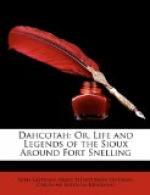Their medicine men, priests, and jugglers, are proverbially the greatest scamps of the tribe. My dear father must forgive me for reflecting so harshly on his brother practitioners, and be reconciled when he hears that they belong to the corps of quacks; for they doubt their own powers, and are constantly imposing on the credulity of others. On returning from an evening walk, we met, near the fort, a notable procession. First came an old medicine man, whose Indian name I cannot recall; but the children of the garrison called him “Old Sneak”—a most appropriate appellation, for he always looked as if he had just committed murder, and was afraid of being found out. On this occasion he looked particularly in character. What a representative of the learned faculty! After him, in Indian file, came his wife and children, a most cadaverous looking set. To use a western phrase, they all looked as if they were “just dug up.” Their appearance was accounted for in the following ludicrous manner—the story is doubtless substantially true. There was a quantity of refuse medicine that had been collecting in the hospital at the fort, and Old Sneak happened to be present at a general clearing out. The medicine was given to him; and away he went to his home, hugging it up close to him like a veritable old miser. It was too precious to be shared with his neighbors; the medicine of the white man was “wahkun” (wonderful)—and, carrying out the principle that the more of a good thing the better, he, with his wife and children, took it all! I felt assured that the infant strapped to its mother’s back was dying at that time.
The “dog dance” is held by the Sioux in great reverence; and the first time it has been celebrated near the fort for many years, was about five summers ago.
The Chippeways, with their chief, “Hole in the Day,” were down on a visit, and the prairie outside the fort was covered with Indians of both tribes. The Chippeways sat on the grass at a little distance, watching the Sioux as they danced, “to show how brave they were, and how they could eat the hearts of their enemies.” Most of the officers and ladies of the garrison were assembled on the hospital gallery to witness the dance.




